
Przytkowice
Elaboration author
Emilia Karpacz
Monuments
Parishes
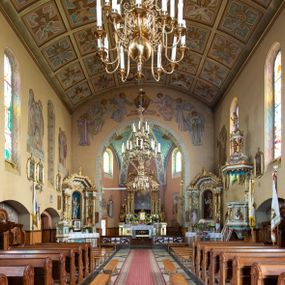
High altar
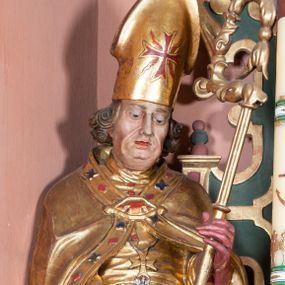
St. Stanislaus
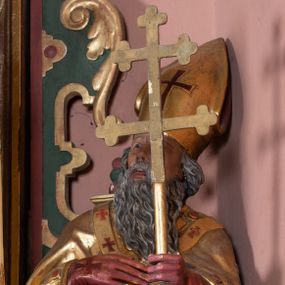
St. Adalbert
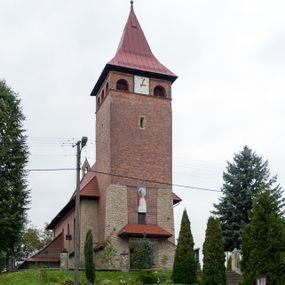
Holy Trinity Church
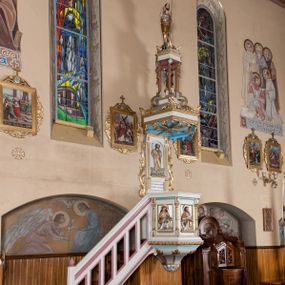
Pulpit
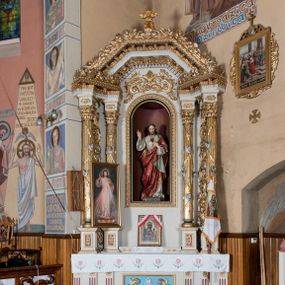
Right side altar of the Most Sacred Heart of Jesus
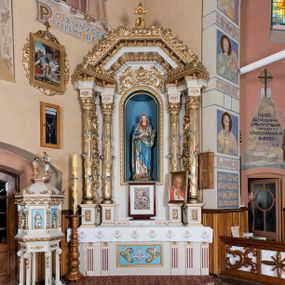
Left side altar of the Most Sacred Heart of Mary
History abstract
Przytkowice was probably founded as a result of the colonisation process conducted since the 13th century in the Skawinka and Skawa basins by the knights of the Radwan coat of arms. The oldest known mention of the town was included in the Peter's pence list from 1345, which means that the parish had already operated in the town at that time. In 1440, the then owners of the village - Stanisław and Jan Przybkowski (Przypkowski, Przytkowski) of the Radwan coat of arms founded a new church in the village. In the second half of the 15th century, a manor farm, an inn and a priest's farm operated in the village. A century later, Jan Przybkowski converted to Arianism. In 1572 he freed his subjects from all feudal burdens and ensured freedom of movement for peasants. Under pressure from the local gentry, he had to withdraw from this decision. According to some researchers, the church in Przytkowice was then converted into an Arian church and returned to Catholics at the end of the 16th century or in the first decade of the 17th century, after Anna Zebrzydowska, the sister of the bishop of Cracow, Andrzej Zebrzydowski, from the Radwan coat of arms, took over part of the Przytkowice estate. Such version of events was not confirmed by the analysis of the contents of the records from the episcopal visitation in Przytkowice in 1598. The parish church was described as remaining in the hands of Catholics. The first references to the division of Przytkowice into Upper and Lower Przytkowice also date back to the end of the 16th century. In the first half of the 17th century the main manor farm in Górne Przytkowice was held by Mikołaj Zebrzydowski, the voivode of Cracow, the starost of Lanckorona and the founder of the sanctuary of the Passion of Christ on the slopes of Mount Żar, located a few kilometres away from the village (today the famous complex in Zebrzydowska Calvary placed on the UNESCO World Heritage List), and afterwards the estate was taken over by his son, Jan. The so-called Lower Manor house in Przytkowice was still in the hands of the Przybkowski family and remained in their possession at least until 1644. During the Swedish Deluge, Charles Gustav's army plundered the area. In 1667 Mikołaj Zebrzydowski's grandson Michał died, and the part of the village belonging to the Zebrzydowski family was taken over by the husband of his daughter, Anna - John Charles Czartoryski. In 1715 the owners of the town were Prince Joseph Czartoryski and Dezydery Jagniątkowski. In the 18th century, the village inhabitants earned their living mainly from agriculture, however shoemaking craft also flourished both in Przytkowice and the surrounding villages. In 1772, as a result of the First Partition of Poland, Przytkowice became part of the Austrian Empire. The Czartoryski family remained the owners of the settlement and other neighbouring estates. During the reign of Prince Kazimierz Czartoryski, the estate was governed by Jan Kanty Brandys, settled in Brody. After the prince's death, in 1835, he bought the estate from his heirs, including Przytkowice and Brody (he settled in the latter). It was later inherited by his son, Kazimierz. In 1841, a primary school was established in Przytkowice. The local peasants became the owners of the land they were using after the Vienna Parliament's decision in 1848 to introduce an enfranchisement reform, which also relieved the peasants of any burden of serfdom, especially feudal service. The manor house in Przytkowice remained in the hands of the Brandys family throughout the 19th century, at the same time gradually being parcelled and reduced. Finally, the manor buildings in Upper Przytkowice with 48 hectares of land were purchased by the Ocetkiewicz family from Cracow. In 1910 a Voluntary Fire Brigade was established in the village. In 1911 a new storey building of a primary school in Przytkowice was erected. After the outbreak of World War II, Przytkowice became part of the General Government. In retaliation for the killing by a local partisan group of a Volksdeutsch collaborating with Gestapo on the border of Przytkowice and Zebrzydowice, 10 prisoners brought from a Cracow prison in Montelupich were shot. In January 1945, the so-called Battle of Przytkowice between the retreating Wehrmacht forces and the advancing Red Army forces took place. Four villagers died and five were wounded. The parsonage and three private houses burned down. At the turn of the 1950s and 1960s, electrification of the village took place. After 1989 many shoe and uppers' repair shops were established in Przytkowice. In the 1990s the town's inhabitants lived to see gas connections and, at the end of the 20th century, a new school complex.
How to cite?
Emilia Karpacz, "Przytkowice", [in:] "The Sacred Lesser Poland Heritage", 2026, source: https://sdm.upjp2.edu.pl/en/places/przytkowice-1